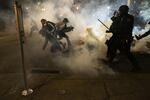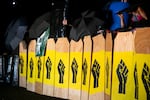
Protesters scramble to get away from approaching police firing tear gas and impact munitions in downtown Portland, Ore., July 4, 2020, during demonstrations against systemic racism and police violence.
Jonathan Levinson / OPB
On a Saturday night in mid-August, 22-year-old K was showing her sister how to put on a gas mask and helmet before going to meet other demonstrators in Portland’s Laurelhurst Park.
“It has to seal to your face or the tear gas will get under it,” K explained, as she adjusted her sister’s mask.
K asked OPB to not use her full name because she fears retaliation for attending demonstrations.
“If the cops call a riot, then you have to put on the respirator and then put the helmet and stuff on over it,” K said. “But you’ll know. Most nights they’ll announce it first and so you’ll know when to put it on.”
Nightly protests passed their 90th day this week. Over the course of nearly three months, crowd sizes have ranged between as few as 100 people and as many as 10,000. Between May 29 and Aug. 27, the Portland Police Bureau declared 23 riots and 22 unlawful assemblies — a figure that doesn’t include nights that started as unlawful assemblies and were later declared riots. But what specific actions lead to a protest being declared a riot or unlawful assembly aren’t always clear, in part because the laws governing those declarations are vague. They also have roots in Oregon’s deeply racist past.
On that mid-August night, K, her sister and fellow protesters marched to the Penumbra Kelly Building in East Portland. It’s a site used by both city police and the Multnomah County Sheriff’s Office. Amidst chants such as “No cops! No prisons! Total abolition,” protesters played music and yelled at officers who were positioned in their cars about 100 feet away. A couple of protesters spray-painted the building while others threw water bottles. Police said rocks were also thrown.
After three hours, the moment K warned about came: A booming announcement echoed from a loudspeaker.
“This is the Portland Police Bureau. We’re declaring this a riot,” the by now familiar announcement came. “You need to leave the area to the west. If you do not leave the area, you may be subject to use of force to include crowd control munitions, pepper spray or tear gas.”
Unfazed, protesters lined up with homemade shields and umbrellas to protect against impact munitions and tear gas. A line of officers in riot gear rushed straight into the group, while someone played “The Imperial March” on a loudspeaker. Video from the clash shows a few moments as police and protesters were engaged in hand-to-hand combat, the police grabbing at the protesters’ shields and swinging their batons.
Police jump into protestor shields, then start swinging pic.twitter.com/sapYPgSftX
— Sergio Olmos (@MrOlmos) August 16, 2020
‘Tumultuous and violent conduct’
“A riot is when six or more persons engage in tumultuous and violent conduct,” Portland Police Bureau Deputy Chief Chris Davis recently explained in a video posted online, “thereby intentionally or recklessly create a grave risk of causing public alarm.”
Davis said officers provide warnings and give protesters time to leave before dispersing the crowd. But how officers decide when enough “tumultuous” conduct happens to justify a riot declaration is subjective, and the dispersal inevitably affects hundreds of people who are not acting violently.

A Portland police officer fires a tear gas canister into a crowd of demonstrators on day 76 of protests against systemic racism and police violence.
Jonathan Levinson / Jonathan Levinson
“Ideally, those engaged in the event would follow the lawful orders given and peacefully leave and no force would be necessary during a dispersal,” Davis said.
On May 29, the first night of mass protests in Portland, police declared a riot after thousands of people poured into downtown, started a small fire in the ground floor of the Multnomah County Justice Center and looting broke out.
They declared a second riot the following night. On both nights, officers used tear gas to disperse crowds. But then for nearly a month, police continued to use tear gas without declaring a riot.
Alarmed by the frequency and amount of tear gas being used, state lawmakers passed legislation during an emergency session in June to address racial justice and policing. They hoped to raise the bar on tear gas use by making it only acceptable to use during a declared riot.
“We were hearing that people were getting caught in these tear gas deployments,” said state Rep. Janelle Bynum, D-Clackamas, one of the bill sponsors. “And they felt like they didn’t have any warning. They felt they were trapped.”
The bill was signed into law June 30. That evening, police declared a riot for the first time in a month and blanketed a North Portland neighborhood in tear gas. Between June 30 and Aug. 27, police have declared 20 riots.
“What I didn’t expect was for the bar [to declare a riot] to be so low,” Bynum said.
She noted the history of Oregon’s riot laws are also relevant to the moment.
“A lot of the riot and crowd control philosophy and statute was developed around the ’60s and ’70s when protests around some of the very same things — rights for Black people — were taking place in the state and particularly in Portland,” Bynum said.

Protesters line up with homemade shields in front of the Penumbra Kelly building soon after police declared a riot on Day 79 of protests against systemic racism and police violence.
Jonathan Levinson / Jonathan Levinson
Constituent letters written in 1967 to then Portland Mayor Terry Schrunk, a former sheriff, suggest the mayor found himself caught between critics who said protest damage was exacerbated by the police department’s soft response and letter writers who said they believed the unrest was the result of young people with little to lose.
In the wake of widespread protest throughout the summer of 1967, and anticipating more unrest in the months ahead, Schrunk and city officials modified city ordinances defining what qualified as a city emergency.
The laws have changed over time, but policy makers today are again dealing with public pushback over protests and how to clarify legal definitions around public unrest.
‘We do this every night’
On some nights during 2020′s protests, Portland police have declared unlawful assemblies within minutes of people arriving.
“But then the riot part? Who knows,” said Folasade Ogunfiditimi, a protester who’s been coming out since the end of May. “Like a half-empty water bottle maybe? Somebody could walk on their property and they declare it a riot. It could be anything or nothing.”
Ogunfiditimi said she’s been protesting because Black lives matter and she sees policing, with its history in slave catching, as a fundamentally corrupt institution.
And, she said, the way the police are treating protesters proves demonstrators’ point. She thinks on most nights officers use excessive force indiscriminately — all under the justification that law enforcement is stopping a riot.
“They’re very finicky, very emotional,” she said. “They show in their actions they don’t care what they do.”
As Ogunfiditimi spoke, a line of riot police appeared at the end of the street. She marched off chanting, “Stay together, stay tight. We do this every night.”
